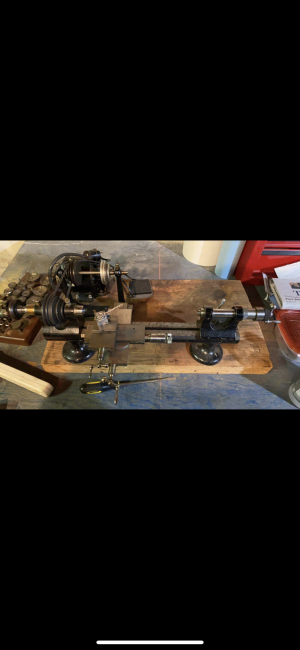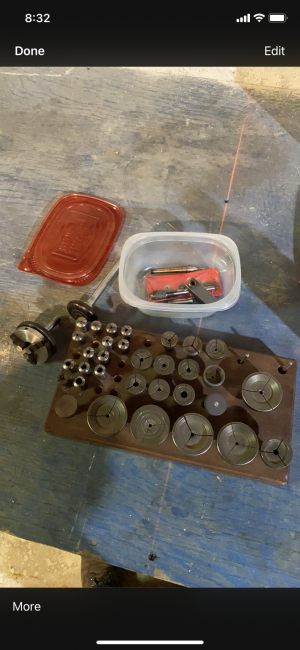-
Welcome back Guest! Did you know you can mentor other members here at H-M? If not, please check out our Relaunch of Hobby Machinist Mentoring Program!
You are using an out of date browser. It may not display this or other websites correctly.
You should upgrade or use an alternative browser.
You should upgrade or use an alternative browser.
What Did You Buy Today?
- Thread starter darkzero
- Start date
- Joined
- Jan 20, 2021
- Messages
- 294
@slodat
Nice job on the RPC.
I'm curious about the vibration isolators you used under the idler motor.
I haven't seen that configuration before.
Can you identify the source?
Of course. They are an ac mount. Inexpensive and seem to be great for this application.
The manufacturer says to not rigid mount the idler. This is what I came up with.
- Joined
- Sep 8, 2019
- Messages
- 4,360
3 cast iron straight tail lathe dogs (1-1/2”, 1-3/4” and 2”). These are economy imports, with an average cost of $15 each.
While my face plates for both lathes use 5/8” T-slot nuts (with 1/2”-13 threaded dog drivers), my 4J chuck that has T-slots calls for 18mm T-slot nuts. These T-slot nuts are M16 X 2.0, so I bought two black oxide 1018 steel TECO brand M18 T-slot nuts, 1 meter of bare steel M16 X 2.0 all thread to make the dog driving pins, & a few M16 X 2.0 nuts.
While my face plates for both lathes use 5/8” T-slot nuts (with 1/2”-13 threaded dog drivers), my 4J chuck that has T-slots calls for 18mm T-slot nuts. These T-slot nuts are M16 X 2.0, so I bought two black oxide 1018 steel TECO brand M18 T-slot nuts, 1 meter of bare steel M16 X 2.0 all thread to make the dog driving pins, & a few M16 X 2.0 nuts.
Last edited:
- Joined
- May 13, 2019
- Messages
- 1,016
I have thought about buying one of these. Would be very interested in you opinion after you have had a chance to use it.
I've posted my impressions of the Drill Doctor 750X on another thread so as to not derail discussions here.
- Joined
- Nov 26, 2017
- Messages
- 1,531
Of course. They are an ac mount. Inexpensive and seem to be great for this application.
The manufacturer says to not rigid mount the idler. This is what I came up with.
Really nice installation. I am curious as I have not had to do this YET.
So looking at the images you posted, it appears as though the single phase power comes into the Eaton disconnect, then into the American Rotary phase inverter, which is also fed from the idler motor, then that will go to a traditional 3 phase distribution panel and from there you can distribute the power to multiple machines, is that correct? Just trying to put this right in my head.
I would also assume that if any of the 3 phase loads require 480V instead of 240V you would then need to install a stepup transformer between the distribution panel and the load.
- Joined
- Jan 20, 2021
- Messages
- 294
Really nice installation. I am curious as I have not had to do this YET.
So looking at the images you posted, it appears as though the single phase power comes into the Eaton disconnect, then into the phase inverter, which is also fed from the idler motor, then that will go to a traditional 3 phase distribution panel and from there you can distribute the power to multiple machines, is that correct? Just trying to put this right in my head.
Single phase power comes in from the panel above. Idler is to the right of the panel, in the next room. The disconnect is between the converter and the three phase panel.

The panels in that photo starting at the left are dust collection automation PLC, 240v sub panel, 240v main panel. Second row on the left is an Ecobee thermostat controlling five Cadet Hot One heaters throughout the shop, vfd and controls for spray booth exhaust fan the next two are impulse relay box for lighting contactor and then the mechanically held lighting contactor. Bottom left is three phase disconnect headed to three phase panel and lastly the American Rotary converter.
I can make a thread about the automation in my shop if that’s something that interests you guys.
- Joined
- Nov 26, 2017
- Messages
- 1,531
Single phase power comes in from the panel above. Idler is to the right of the panel, in the next room. The disconnect is between the converter and the three phase panel.

The panels in that photo starting at the left are dust collection automation PLC, 240v sub panel, 240v main panel. Second row on the left is an Ecobee thermostat controlling five Cadet Hot One heaters throughout the shop, vfd and controls for spray booth exhaust fan the next two are impulse relay box for lighting contactor and then the mechanically held lighting contactor. Bottom left is three phase disconnect headed to three phase panel and lastly the American Rotary converter.
I can make a thread about the automation in my shop if that’s something that interests you guys.
Thank you for the information. Interesting and well laid out setup you have there.
- Joined
- Nov 23, 2014
- Messages
- 2,647
Few recent pickups. I bought a DoAll 16" vertical band saw a month ago and was noodling over a design for a mobile base. The saw weighs around 1000 lbs. I checked out Grizzly for mobile bases design ideas and saw (pun intended) this Super Heavy-Duty mobile base rated at 1300 lbs. for $110. The front/rear of the frame were reinforced twice. First with some 2" x 1/4" thick angle iron. The mobile base is a frame with pads for the equipment in the corners. Problem was the DoAll base is "T" shaped, so nothing in the back corners to set on the mobile base pads. I cut a couple of lengths of angle to bridge the gap, one at the front and one at the back so the saw would stay level. Worked great until I stepped down on the power feed pedal, and as luck would have it, it hit the top of the base frame. The pedal was about 1/8" short of getting to the latch position. So, stuck a couple of 1 1/4" x 3/8" lengths of bar stock on top of the angle to shim the saw up.
Next problem was the cast-iron casters. I didn't realize it, but they had no lube on the axles. Thought I was going to need a machine moving pry bar to roll it around. Shot some LPS 1 lube on the casters and it's now a mobile base. I'm a little nervous about the fixed casters as there are only screw-down foot pads for the swivel casters. The fixed ones support the weight all of the time. I'll probably add a couple of levelers on the straight caster corners to take the load off the casters.
The leveling pads have a nice design that may be useful for other bases. They screws/legs are two-piece. The screw at the top has a magnet on the bottom end, the foot is an un-threaded rod with the foot pad on the end. Unscrew the top to lift the pad; when tightening, the pad hits the floor and the "swivel" is the screw/magnet slipping over the top of the foot rod. The only issue I found was I knocked the two apart when rolling the base over some bumps and separated the pad so it dragged on the floor. On the plus side, it didn't have any weight on it and seemed to slide easily without scrubbing the surface.



Year ago Mr. Pete turned me on to stubby, machine screw length drill bits for my mills. They're quite short compared to jobber length. Advantages are a more rigid drill bit giving an option of skipping pre-drilling the hole with a spotting drill. Also, the shorter length helps with a shorter overall tool length. I bought a set of Norseman stubby fractionals for my Tormach a while back. Picked up this Norseman stubby 1-60 set off eBay for around $90 shipped.

More Mr. Pete fodder. I watched a video years ago with him tapping holes with a tapping head on the drill press. Seemed like a slick way to go if I had a bunch of holes to do. I got "Mr. Pete tool envy" and bought a Procunier 1E tapping head with a straight 1/2" shank off eBay years ago. I didn't research it very well and discovered that they used unique collets by tap size. I thought they'd use a two-jaw chuck like a hand tap wrench, but "no", there's a 0-#6, #8, #10, #12 and 1/4" series of collets. Mine came with a #12; found this set on eBay for $12 each.

Thanks for looking, Bruce
Next problem was the cast-iron casters. I didn't realize it, but they had no lube on the axles. Thought I was going to need a machine moving pry bar to roll it around. Shot some LPS 1 lube on the casters and it's now a mobile base. I'm a little nervous about the fixed casters as there are only screw-down foot pads for the swivel casters. The fixed ones support the weight all of the time. I'll probably add a couple of levelers on the straight caster corners to take the load off the casters.
The leveling pads have a nice design that may be useful for other bases. They screws/legs are two-piece. The screw at the top has a magnet on the bottom end, the foot is an un-threaded rod with the foot pad on the end. Unscrew the top to lift the pad; when tightening, the pad hits the floor and the "swivel" is the screw/magnet slipping over the top of the foot rod. The only issue I found was I knocked the two apart when rolling the base over some bumps and separated the pad so it dragged on the floor. On the plus side, it didn't have any weight on it and seemed to slide easily without scrubbing the surface.



Year ago Mr. Pete turned me on to stubby, machine screw length drill bits for my mills. They're quite short compared to jobber length. Advantages are a more rigid drill bit giving an option of skipping pre-drilling the hole with a spotting drill. Also, the shorter length helps with a shorter overall tool length. I bought a set of Norseman stubby fractionals for my Tormach a while back. Picked up this Norseman stubby 1-60 set off eBay for around $90 shipped.

More Mr. Pete fodder. I watched a video years ago with him tapping holes with a tapping head on the drill press. Seemed like a slick way to go if I had a bunch of holes to do. I got "Mr. Pete tool envy" and bought a Procunier 1E tapping head with a straight 1/2" shank off eBay years ago. I didn't research it very well and discovered that they used unique collets by tap size. I thought they'd use a two-jaw chuck like a hand tap wrench, but "no", there's a 0-#6, #8, #10, #12 and 1/4" series of collets. Mine came with a #12; found this set on eBay for $12 each.

Thanks for looking, Bruce


